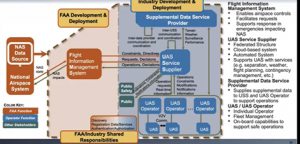By Jenny Beechener
“The next Unmanned Traffic Management (UTM) service is likely to be Strategic Deconfliction based on a standard that ASTM is working on,” said Jay Merkle, Federal Aviation Administration (FAA) UTM Integration Office Director, speaking at NASA’s Project Technical Interchange meeting on 23 February 2021. The FAA published its Remote ID rule in December 2020 and is working on an updated UTM Concept of Operations V3.0 – a successor to V2.0 published in mid-2020 – to support continued development and implementation in the National Airspace System (NAS).
Jay Merkle took the opportunity to set the record straight on the Remote ID rule which some “misinterpreted as removing the network capability”. He said, “the FAA needed more time to figure out network information sharing” and continues to “work hard on a regulatory structure for UTM services”. he emphasised the agency “is strongly supportive of a federated UTM system” and engages with many organisations in order to promote harmonisation of UTM standards across the world.
Chief Engineer for NASA’s UTM project Joey Rios said there is still a great deal of standardisation work still to do and this is progressing in “bite-sized chunks”. He said since NASA commenced its UTM programme five years’ ago, “the agency has discovered a completely new approach to managing airspace in a collaborative manner not thought about before”. This accommodates stakeholder input that complements traditional FAA air traffic control services. NASA has named this UTM-like environment X-ATM and anticipates many concepts will be applicable to conventional NAS operators. “Principles of collaborative airspace management and increased automation are critical to enabling these mobility concepts,” said Joey Rios. “We are creating a collaborative environment that allows the airspace to be shared while taking into account safety concerns and differences in aircraft performance.”
NASA established the UTM Research Transition Team in collaboration with the FAA in 2016 to allow both agencies to work together on UTM development, an initiative that led to the creation of the Joint Management Plan and four working groups. These addressed Concepts & Use Cases; System Architecture & Data Transfers; Sense & Avoid/Conflict Management; and Communication & Navigation. The programme was driven by a risk-based development and test approach which conducted research and demonstrations centred on four technical capability levels (TCL1-4).
NASA has published the findings from this research, and the FAA is now taking forward many of these concepts to develop the future US National Airspace System.
A fundamental principle of UTM is its reliance on a federated system architecture. “This collective set of architectures allows collaborative operations,” explained Joey Rios, “where the central authority architecture can focus on economies of scale and standards; and the constituent units’ architectures have flexibility to pursue autonomous strategies.” The FAA is pursuing these concepts and taking the lessons learned from the research and flight tests with the aim of developing a highly automated, dynamic future airspace structure.
NASA Director of Airspace Operations and Safety Akbar Sultan added: “The UTM construct will provide a federated, service-oriented architecture in the future NAS. We are very excited with what we’ve collectively done in UTM over last five years and we are looking forward to working with our partners as we move towards the transformation of the NAS towards all the future demands of air mobility.”
 |




